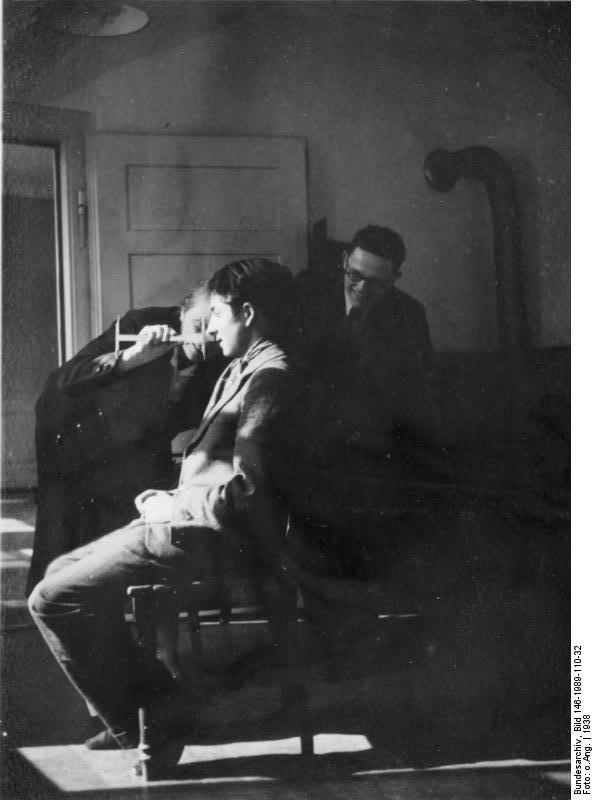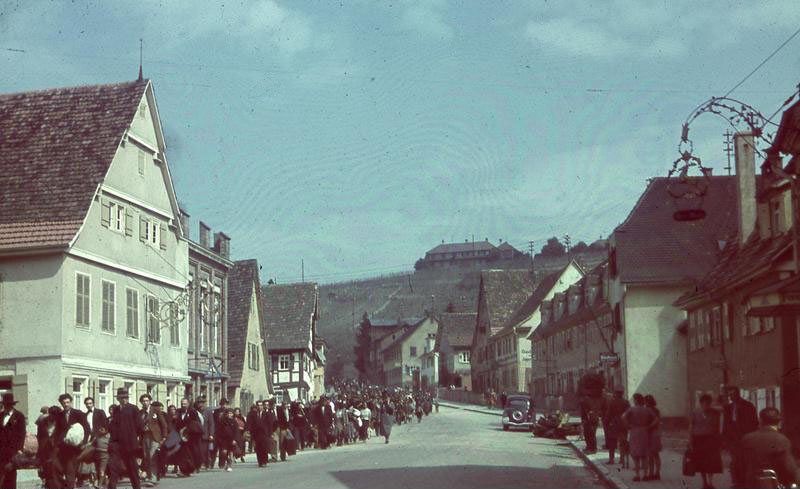As early as 1931, an SS department in Munich had begun to record the "Jews and Gypsies", the two so-called "non-European foreign races". From the beginning of Nazi rule, Sinti and Roma, like Jews, were persecuted and excluded on racist grounds. In 1933, the SS "Race and Settlement Office" in Berlin immediately demanded that "gypsies and gypsy half-breeds" generally be made infertile.
Law for the Prevention of Hereditarily Diseased Offspring of 14 July 1933
The Reich government has adopted the following Act, which is hereby announced:
Section 1
(1) Any person suffering from a hereditary disease may be rendered incapable of procreation by means of a surgical operation (sterilization), if the experience of medical science shows that it is highly probable that his descendants would suffer from some serious physical or mental hereditary defect.
(2) For the purposes of this law, any person who is suffering from any one of the following diseases will be considered as hereditarily diseased: congenital mental deficiency, schizophrenia, cyclical (manic-depressive) insanity, hereditary epilepsy, hereditary St Vitus’ dance (Huntington’s chorea), hereditary blindness, hereditary deafness, any severe hereditary deformity.
(3) Any person suffering from severe alcoholism may be also rendered incapable of procreation.
Among those affected, for example, was Joseph Muscha Müller, born 1932:
 Josef Müller, known as Muscha, was a Sinto and adopted at the age of eighteen months. At the age of 12, he was forcibly sterilised. Later, he came across the doctor who had operated on him again. The latter was by then the senior consultant at a hospital in Flensburg.
Josef Müller, known as Muscha, was a Sinto and adopted at the age of eighteen months. At the age of 12, he was forcibly sterilised. Later, he came across the doctor who had operated on him again. The latter was by then the senior consultant at a hospital in Flensburg.
"One day there was a knock on the classroom door. Mr Rüllemann was asked to step outside by a man and a woman. After some time it got rather heated outside the door. We heard Mr Rüllemann saying: ‘I cannot and must not hand the child over to you.’ Then the door was pulled open, Mr Rüllemann pushed aside and the two of them were standing in the classroom. […]
A terrible fear came over me, and I felt the impending danger threatening me. […] In the corridor they both told me I had appendicitis and must have stomach ache. […] I was taken to a strange hospital and was given a room on an otherwise empty floor. I didn’t feel ill and tried to run away. […] But in the corridor I ran right into the arms of Dr Rothmaler, who realised what I was up to. He slapped me in the face and kicked me. Then all my clothes were taken away and the nurses had to tie me to the bed. […] I tried again to explain to Dr Rothmaler that I didn’t have a stomach ache at all and that he had to let me go. He just laughed.
My will was broken. I didn’t feel afraid any more because I was indifferent to everything by then. He was the doctor who sterilised me. Now I really did have stomach ache and I couldn’t walk properly for ages. […]
It was many years before I realised that they hadn’t removed my appendix. At the time they couldn’t even tell me because I was far too young to understand what had happened to me."
The "Nuremberg Laws" 1935
Applying the Nuremberg Laws” of 1935 the Nazis equated Sinti and Roma with the Jews in legal persecution.
As early as 3 January 1936 the Minister of the Interior, Wilhelm Frick, decreed in a confidential communication to all state governments, registry offices, regulatory authorities and health offices that the so-called Blood Protection Law be applied, remarking: "the foreign races include all other races; in Europe, apart from the Jews, that habitually means only the Gypsies."
This was the first time that a ministerial Nazi document officially put the Jews and gypsies on the same footing.
 The so-called expert assessment of Maria Franz's race, source: Landesarchiv Nordrhein-Westfalen, Abteilung Rheinland, BR 2034, Nr. 13
The so-called expert assessment of Maria Franz's race, source: Landesarchiv Nordrhein-Westfalen, Abteilung Rheinland, BR 2034, Nr. 13
"Reich Central Office to Combat the Gypsy Nuisance" 1939
["Reichszentrale zur Bekämpfung des Zigeunerunwesens"]
In October 1938, Himmler, the Reichsführer SS and head of the German police, integrated the Gypsy Police Headquarters, established in 1926 in Munich, along with its staff and files into the Reich Criminal Police Office in Berlin (after 27.9.1939 it became Office V of the Reich Main Security Office). There it was renamed the "Reich Central Office to Combat the Gypsy Nuisance". On 8 December 1938 Himmler’s circular or "basic decree" on "Settling the Gypsy Question on the Basis of the Nature of the Race" was issued.
The Reich Main Security Office was to "establish" the racial affinity of the "Gypsies"on the basis of Ritter’s "racial certificates".

Eva Justin and Dr. Adolf Würth (anthropometry, craniometry) measuring the head of a young Sinto, sitting on a chair in a room with oven in a police station, photo taken 1938 by the Rassenhygienische Forschungsstelle am Reichsgesundheitsamt (Racial Hygiene Research Centre at the Reich Health Office, Bundesarchiv Bild 146-1989-110-32
By the end of 1944, around 24,000 of these so-called "certificates" had been drawn up. Himmler’s order for the first deportation of entire Sinti and Roma families to the so-called General Government followed on 27 April 1940.
16 May 1940 was a fateful day for many Sinti: it marked the beginning of the first major mass deportations of whole families to the ghettos, labour and concentration camps in the occupied Polish territories.

Sinti under police surveillance and the observation of bystanders are marching on Königstreet in Asperg, district of Ludwigsburg, Germany. 22 May 1940, © Bundesarchiv R165-244-42
For the first centrally planned deportation of Roma and Sinti from all over West Germany in May 1940, the prison Hohenasperg was used as a stopover for all detained families. Later, in 1943, deportations led to the "Gypsy family camp" of Auschwitz-Birkenau, where the prisoners were murdered.
According to a note in her file Anna Eckstein was deported to the General Government one day after shooting this photo.
In the download section you find a chronology of events against Roma and Sinti.
